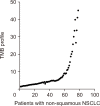Prognostic Significance of Tumor Mutation Burden among Patients with Non-small Cell Lung Cancer Who Received Platinum-based Adjuvant Chemotherapy: An Exploratory Study
- PMID: 38205359
- PMCID: PMC10774481
- DOI: 10.15430/JCP.2023.28.4.175
Prognostic Significance of Tumor Mutation Burden among Patients with Non-small Cell Lung Cancer Who Received Platinum-based Adjuvant Chemotherapy: An Exploratory Study
Abstract
This study aimed to investigate the prognostic significance of tumor mutation burden (TMB) among patients with non-small cell lung cancer (NSCLC) who received platinum-based adjuvant chemotherapy. Tumor tissue specimens after surgical resection were collected for DNA extraction. Somatic mutation detection and TMB analysis were conducted using next-generation sequencing (NGS). Recurrence status of the patients was assessed in the hospital during the adjuvant chemotherapy period, and long-term survival data of patients were obtained by telephone follow-up. Univariate analysis between TMB status and prognosis was carried out by survival analysis. A retrospective review of 78 patients with non-squamous NSCLC who received platinum-based adjuvant chemotherapy showed a median disease-free survival of 3.6 years and median overall survival (OS) of 5.3 years. NGS analysis exhibited that the most common mutated somatic genes among the 78 patients were tumor suppressor protein p53 (TP53), epidermal growth factor receptor, low-density lipoprotein receptor related protein 1B, DNA methyltransferase 3 alpha and FAT atypical cadherin 3, and their prevalence was 56.4%, 48.7%, 37.2%, 30.7%, and 25.6%, respectively. TMB status was divided into TMB-L (≤ 4.5/Mb) and TMB-H (> 4.5/Mb) based on the median TMB threshold. Relevance of TMB to prognosis suggested that the median OS of patients with TMB-L was significantly longer than that of patients with TMB-H (NR vs. 4.6, P = 0.014). Higher TMB status conferred a worse implication on OS among patients with non-squamous NSCLC who received platinum-based adjuvant chemotherapy.
Keywords: Adjuvant chemotherapy; Non-small cell lung cancer; Platinum; Prognosis.
Copyright © 2023 Korean Society of Cancer Prevention.
Conflict of interest statement
CONFLICTS OF INTEREST No potential conflicts of interest were disclosed.
Figures






Similar articles
-
[Influence of genetic variation of programmed death-ligand 1 (PD-L1) on the prognosis of patients with non-small cell lung cancer who received platinum-based adjuvant chemotherapy].Zhonghua Yi Xue Za Zhi. 2020 Sep 15;100(34):2682-2688. doi: 10.3760/cma.j.cn112137-20200503-01405. Zhonghua Yi Xue Za Zhi. 2020. PMID: 32921017 Chinese.
-
The landscape of gene mutations and clinical significance of tumor mutation burden in patients with soft tissue sarcoma who underwent surgical resection and received conventional adjuvant therapy.Int J Biol Markers. 2020 Sep;35(3):14-22. doi: 10.1177/1724600820925095. Epub 2020 Jun 10. Int J Biol Markers. 2020. PMID: 32520634
-
Integration of comprehensive genomic profiling, tumor mutational burden, and PD-L1 expression to identify novel biomarkers of immunotherapy in non-small cell lung cancer.Cancer Med. 2021 Apr;10(7):2216-2231. doi: 10.1002/cam4.3649. Epub 2021 Mar 2. Cancer Med. 2021. PMID: 33655698 Free PMC article.
-
Association of Survival and Immune-Related Biomarkers With Immunotherapy in Patients With Non-Small Cell Lung Cancer: A Meta-analysis and Individual Patient-Level Analysis.JAMA Netw Open. 2019 Jul 3;2(7):e196879. doi: 10.1001/jamanetworkopen.2019.6879. JAMA Netw Open. 2019. PMID: 31290993 Free PMC article.
-
Prognostic Impact of Tumor Mutation Burden in Patients With Completely Resected Non-Small Cell Lung Cancer: Brief Report.J Thorac Oncol. 2018 Aug;13(8):1217-1221. doi: 10.1016/j.jtho.2018.04.003. Epub 2018 Apr 12. J Thorac Oncol. 2018. PMID: 29654927
Cited by
-
Translational Insights in the Landscape of Salivary Gland Cancers: Ready for a New Era?Cancers (Basel). 2024 Feb 28;16(5):970. doi: 10.3390/cancers16050970. Cancers (Basel). 2024. PMID: 38473330 Free PMC article. Review.
-
Genomic profiles and prognostic biomarkers of resectable lung adenocarcinoma with a micropapillary component.Front Oncol. 2025 May 29;15:1574817. doi: 10.3389/fonc.2025.1574817. eCollection 2025. Front Oncol. 2025. PMID: 40510148 Free PMC article.
References
-
- Bray F, Ferlay J, Soerjomataram I, Siegel RL, Torre LA, Jemal A. Global cancer statistics 2018: GLOBOCAN estimates of incidence and mortality worldwide for 36 cancers in 185 countries. CA Cancer J Clin. 2018;68:394–424. doi: 10.3322/caac.21492. Erratum in: CA Cancer J Clin 2020;70:313. - DOI - PubMed
LinkOut - more resources
Full Text Sources
Research Materials
Miscellaneous
